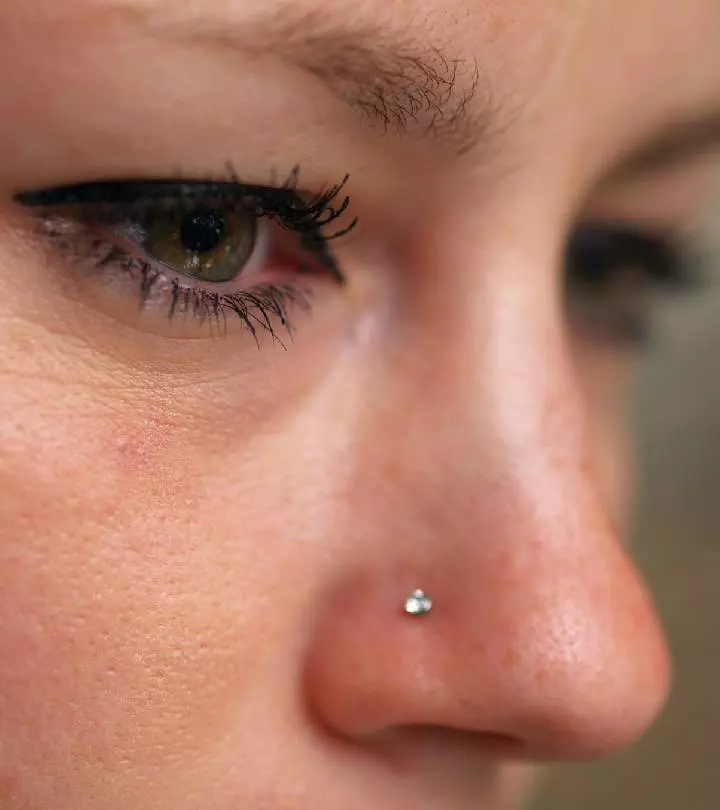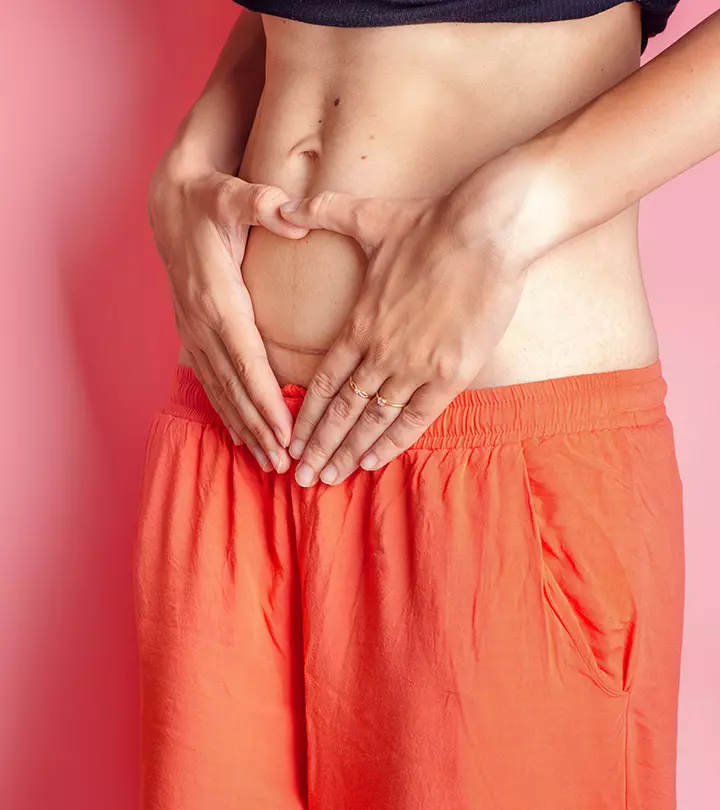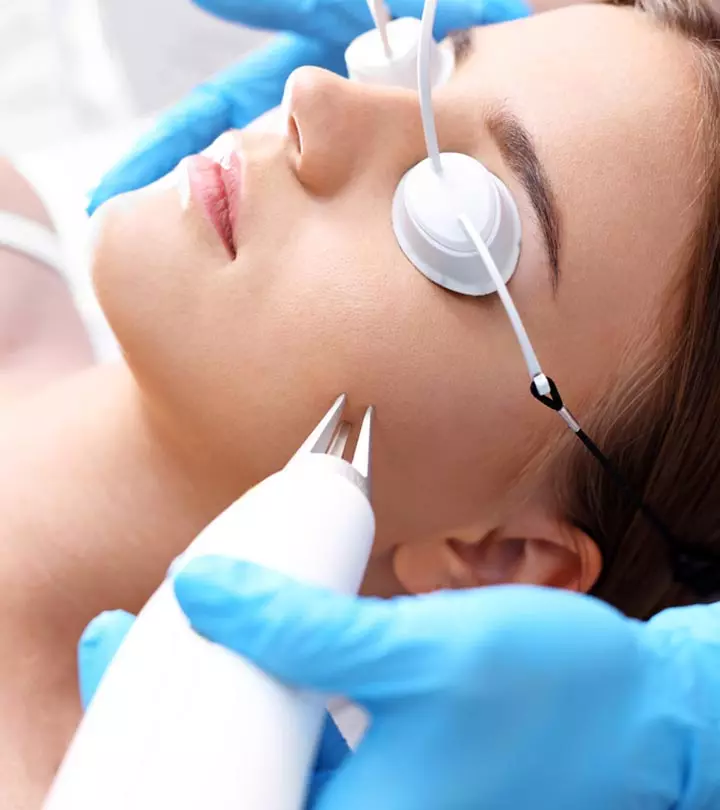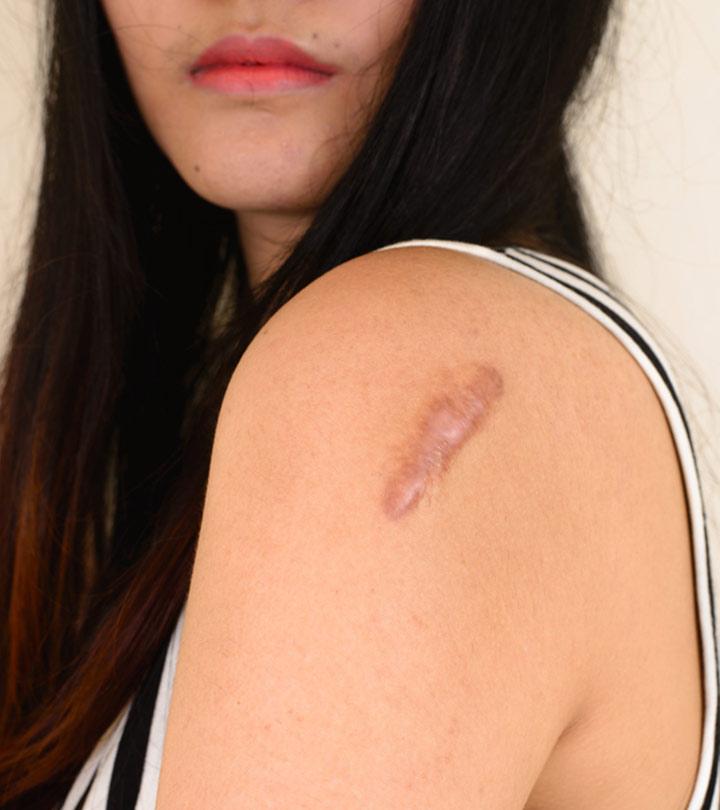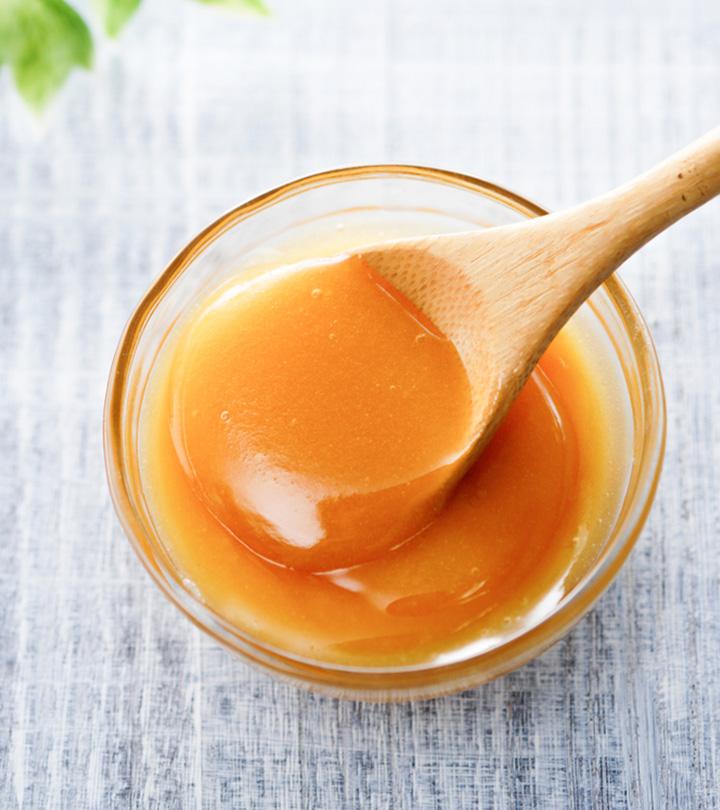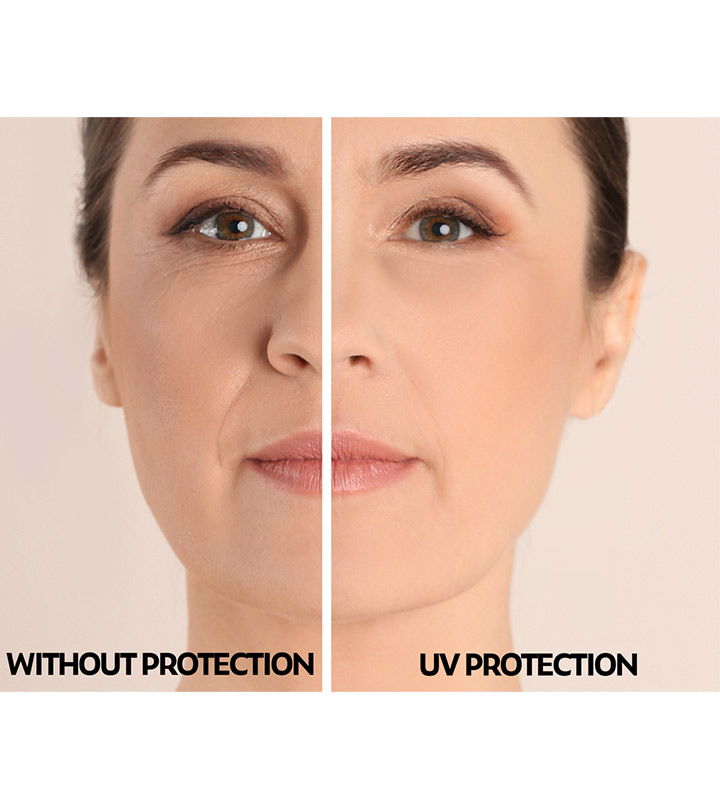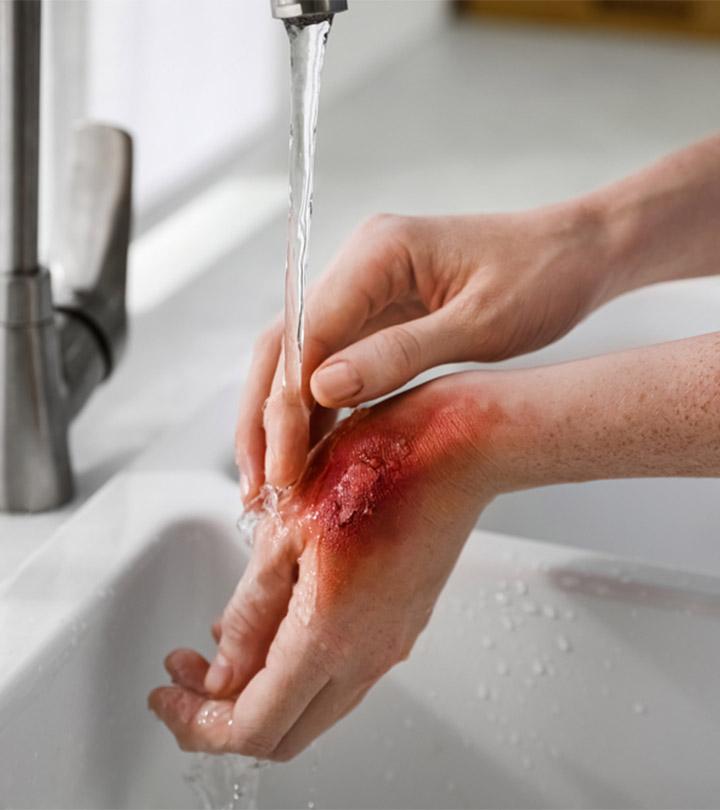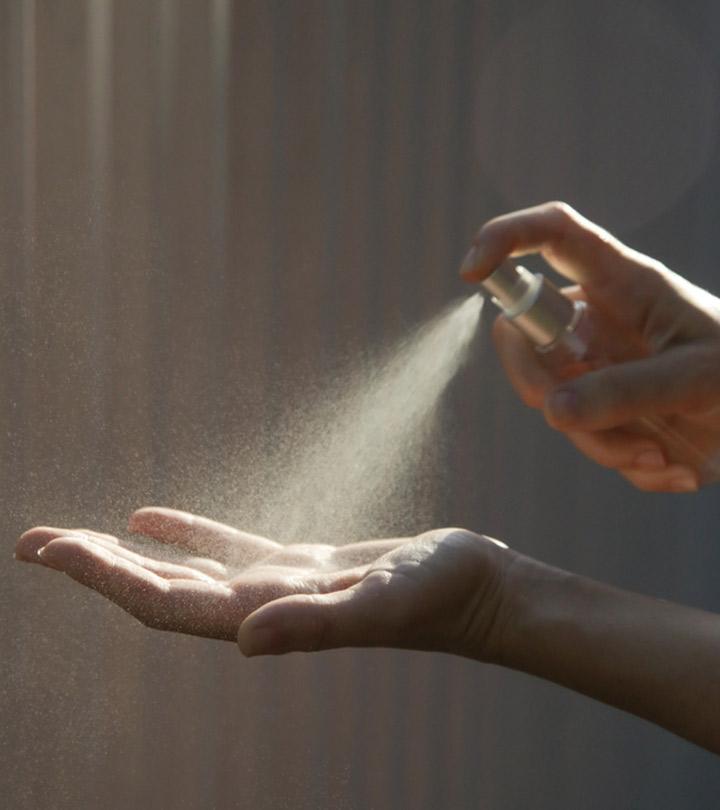C-section Scars: Types, Healing Stages, And Side Effects
Embrace strength, love, and healing through self-care and C-section scar recovery.

Image: Shutterstock
A scar is left behind when a baby is delivered through Cesarean section, commonly known as a C-section. A C-section is a major operation that can leave you with considerable scarring on your skin. This article will cover all you need to know about C-section scars and how to reduce them. Keep reading!
In This Article
Types Of C-Section Scars
There are mainly two types of incisions a surgeon may use during a C-section. These include:
1. Vertical Cut
Vertical cut is more common in cases where emergency C-sections are done simply because they are faster to do. (1) If the baby has a health emergency during the delivery, it becomes essential for the surgeon to get to them quickly and begin treating them. However, it is important to note that a vertical incision is considered more painful and takes a longer time to heal.
2. Horizontal Cut
Horizontal C-section cut is more common in planned surgeries (1). These incisions are made low on your torso, just above your pubic hairline. Most expecting mothers prefer a horizontal incision during C-section delivery because they are easier to hide. They also heal much faster and cause less pain as compared to vertical incisions.
In most cases, both horizontal C-section scars and vertical C-section scars heal properly. However, sometimes the body’s healing process can be abrupt, leading to problems with scarring. There are mainly two types of scars that can crop up here. These include:
1. Keloid Scar
A keloid C-section scar occurs when your scar tissue extends much beyond the original boundaries of the wound, thus resulting in lumps of scar tissue around the incision (2).
2. Hypertrophic Scar
A hypertrophic scar, on the other hand, is much firmer, thicker, and usually more raised as compared to a normal scar. However, unlike a keloid scar, it usually stays within the borders of the original incision (2).
 Did You Know?
Did You Know?Now that you know the types of scars a C-section can leave behind, let’s talk about how to take care of them.
How To Take Care Of C-Section Scars During and After Healing
After having a C-section, it is normal to experience some sort of soreness, pain, and bleeding. This is simply because it is a major abdominal surgery, and you need time to heal and recover from it. It also means that you will need to be more cautious of what you can and cannot do as your body heals.
Here are some C-section scar care basics you need to take care of during and after healing from the procedure:
A. Physical Activity After A C-Section Surgery
The key change you need to make after a C-section is altering your physical activity until you’ve healed. Here are some of the guidelines to follow during and after healing that will help your body recover faster.
What To Do
- Take an adequate amount of rest.
- Include walking in your daily routine. It helps prevent blood clots and constipation.
- Take light showers and pat the incision dry gently with a soft towel.
- Hold a pillow over your incision when you need to cough or laugh hard.
What Not To Do
- Do not lift any heavy items, especially if it’s heavier than your baby.
- Do not do any kind of rigorous activity or core muscle exercises until cleared by your doctor.
- Do not use tampons without your doctor’s permission.
- Do not take the stairs repeatedly or soak in public pools or hot tubs.
- Do not hesitate to ask for help with household chores such as laundry, cleaning, or babysitting.
B. Incision Care
After delivering by C-section, incision care is of utmost importance. Here are some things that you should and shouldn’t do.
Things To Do
- Always keep the area dry and clean.
- Use warm, soapy water to wash your incision daily. Also, pat the area dry after cleaning.
- If tape strips are used on your incision, it is best to let them fall off on their own. This usually takes about a week.
Things Not To Do
- Do not use harsh cleaning products that can make your wound heal slowly.
C. Diet After A C-Section
Getting the right nutrition is also an essential part of taking care of your body after C-section surgery.
Things To Do
- Drink an adequate amount of water and other liquids.
- Eat a well-balanced, healthy diet daily.
- Make sure to take a fiber supplement daily. This will help you avoid constipation.
Things Not To Do
- Do not go on a crash diet. Ask your doctor when is the right time for you to start trying to lose the baby weight.
In the next section, we will cover the ways to minimize scarring after C-section surgery.
Ways To Minimize Scarring After A C-section
There are several C-section scar tissue removal treatments that you can try out so that you are left with only a thin line as a reminder of your surgery.
- Silicone Sheets/Gel
Silicone is known to help skin restore and strengthen connective tissue. It can also soften and flatten your scars, as well as reduce scar pain. To minimize your scar, you can either apply silicone sheets or some silicone gel to the incision (3), (4). You can also use C-section scar cream to speed up the healing process.
- Steroid Injections
Steroid injections help reduce inflammation and pain throughout the body and heal and improve the appearance of larger scars (1). They are especially useful for treating keloid scars. However, it is important to note that you might need multiple monthly injections to achieve the desired results.
- Scar Massage
Another way to minimize scarring is by regularly massaging your scar after it heals. This kind of massaging of the scar is said to stimulate the skin and encourage blood flow, which leads to cellular growth and the gradual fading of the scar. However, there is not enough conclusive scientific evidence to prove that it is effective (5).
 Pro Tip
Pro TipNow, let’s check out how long it takes for a C-section scar to heal.
How Long Does It Take For A C-Section Scar To Heal?
Generally, it takes about six weeks for a C-section scar to heal. This means that you’ll likely be able to resume all your regular activities in six weeks.
This C-section scar healing time allows the incision to mature. Therefore, when you perform any kind of strenuous activity, there are minimal chances of the scar’s integrity being compromised and its appearance worsening.
Wondering how to treat C-section scars? Read on to know more.
What Are The Cosmetic Options Available To Minimize A C-Section Scar
While there is no way to get rid of a C-section scar completely, there are certain options that can help you improve its overall look and feel. Among these are –
- Laser Therapy
Laser therapy for scar healing uses beams of light to improve the damaged parts of the skin (7). The procedure can soften and improve the appearance of scars and remove raised scar tissue. However, to achieve the desired results, you may need multiple laser treatment sessions.
- Intralesional Steroid Injections
If the scar is showing a tendency towards becoming a keloid, steroid injections are given into the scar tissue by a qualified dermatologist. This procedure is considered the gold standard in the nonsurgical management of hypertrophic and keloid scars. Usually, triamcinolone acetonide (TAC), a type of synthetic corticosteroid, is administered. This compound helps in reducing the thickness and bulk of the scar. It also alleviates itching and pain, and prevents recurrences.
However, it is important to note that this is not a good choice if your C-section scar is small because a tummy tuck scar is typically longer (7).
- Scar Revision
In case of a deep and noticeable scar, scar revision is a great way to open and re-close the scar (8). The treatment helps remove damaged skin and makes it less noticeable to blend well with your surrounding skin.
Worried about the side effects of C-section scars? Read on to know more.
Are There Any Side Effects Of C-Section Scars?
You may experience numbness, scar pain, bleeding, and cramping for the first few weeks after your C-section surgery. C-section scar itching is another common symptom that occurs. However, it is best to resist the urge to scratch the healing wound.
If you notice heavy bleeding or any kind of oozing from your incision site, increased scar pain, or have a consistent fever higher than 100.4°, consult your doctor immediately as these could be signs of an infection (9).
A questionnaire survey, conducted in two Irish tertiary maternity centers, gathered responses from 347 women with one previous cesarean section (CS) out of 633 participants (54.8%). Regarding future mode of birth, 39.5% preferred vaginal birth after cesarean delivery, and 80% were willing to participate in a randomized trial on mode of birth in a subsequent pregnancy.
In the next section, we are going to explore some of the ways to reduce C-section scars.
Ways To Prevent Cesarean Scars
Since every woman’s body is different, some of them tend to scar more heavily after an injury or surgery. However, if proper care is taken, there are high chances of keeping your C-section scarring to a minimum. Some of the ways you can prevent a C-section scar include:
- Always Keep The Incision Clean
Make sure to follow your doctor’s instructions about taking care of your incision. Negligence can lead to an infection that can not only put your health at risk but can also make scarring worse. Therefore, it is important to keep the area clean and follow the instructions for dressing and caring for your stitches carefully.
- Take Proper Care Of Your Body
Taking care of your body after the procedure plays an important role in preventing scarring. Make sure to stay hydrated and eat healthy after your C-section.
- Do Not Stress Your Incision
Stressing by moving around too much, bending, and twisting can make your incision worse. It will then take more time to heal and potentially scar more heavily. It is best to take adequate rest and let it heal before you get back to your day-to-day activities.
It is important to massage and mobilize your C-section scar to make
Tips To Mobilize Your C-Section Scar
C-section scar tissue mobilization is a combination of various soft tissue manipulation techniques, which include skin rolling, deep fascia manipulation, and myofascial release. It helps ease the pain caused by the surgery. Most physical therapists typically start this treatment six weeks after the delivery and after clearance from a doctor (10).
Some of the tips for doing scar mobilization include:
- Start skin rolling and light massage as soon as your scar appears fully healed on the surface. Do this by applying light pressure on your scar and massaging it in circles from end to end.
- Skin rolling mainly consists of pinching and lifting the tissue of the skin right over the scar. Use lotion or oil to help make the treatment more comfortable.
- Spend up to 5 minutes mobilizing your scar every day. The best time to do this is right out of the shower, as it makes it slightly more comfortable when the tissue is warm and flexible.
But, is massaging a C-section scar a good idea? Find out in the next section.
Is Massaging A C-Section Scar Good Idea?
Yes, gently massaging the C-section scar is a good idea as it helps to reduce chronic scar tissue pain (11). It may also help reduce the appearance of the scar, though there is not enough scientific evidence to prove the same.
Once you get your doctor’s clearance, you can start massaging your scar, beginning from four to six weeks post-surgery. The best way to massage your scar is by working it with a rubbing motion. Massage it side to side first, followed by up and down, and then diagonally.
The other way to do it is by lifting and rolling the scar between your thumb and forefinger. Doing this kind of massage two to three times a day for five to 10 minutes at a time can keep the scar soft, pliable, and cosmetically appealing.
Further, scar massaging can also help prevent chronic pelvic pain, which is a common cause of concern when the scar is thick and deep and limiting the mobility of muscles and connective tissue, leading to severe pain and mobility issues (11).
A C-section operation can leave a woman with horizontal or vertical c-section scars. In order to recover safely, you must take adequate rest and keep your scars dry and clean to allow them to heal properly. Eating a balanced diet and staying hydrated are key to speeding up the healing process. Since you cannot completely get rid of a C-section scar, you can go for cosmetic procedures such as laser treatment or scar revision to minimize the appearance of the scars. If you experience bleeding, soreness, and high fever, consult a doctor immediately.
Frequently Asked Questions
How painful is a cesarean scar?
The area around the cesarean scar may be tender for a while after the surgery. Some have reported that the overgrown scar tissue can cause lower abdominal pain, numbness, and tightness. Also, a lack of abdominal muscle activity can cause you to feel weak or have back pain.
How many C-sections can a woman have?
Each patient and case is unique. Most medical authorities recommend sticking to a maximum of three C-sections.
Do they cut in the same place for a second C-section?
Yes, in an ideal scenario. To avoid creating multiple scars on your abdomen and uterus, your obstetrician should cut through the same scar.
Can a C-section scar reopen after years?
Yes, in extremely rare cases. C-section dehiscence (uterine scar dehiscence) is a condition where the scar tissue separates due to poor healing (12).
Key Takeaways
- A scar is left behind when a baby is born via Cesarean section. There are primarily two types of incisions during a C-section: vertical and horizontal.
- You need to take care of a C-section scar during and after healing from the procedure like physical activity, incision care, and diet.
- Scar massage, silicone sheets or gels, and steroid injections can help reduce scarring after C-section surgery.
- While there is no way to remove a C-section scar entirely, laser therapy, tummy tuc
If you have just undergone a C-section and it has left a scar, here is a daily routine to flatten it. For more essential tips and practices to support scar healing and wellness, click here to watch the video!
References
Articles on StyleCraze are backed by verified information from peer-reviewed and academic research papers, reputed organizations, research institutions, and medical associations to ensure accuracy and relevance. Read our editorial policy to learn more.
- Comparison of Transverse and Vertical Skin Incision for Emergency Cesarean Delivery
https://www.ncbi.nlm.nih.gov/pmc/articles/PMC3228350/ - Hypertrophic Scarring and Keloids: Pathomechanisms and Current and Emerging Treatment Strategies
https://www.ncbi.nlm.nih.gov/pmc/articles/PMC3022978/ - The Use of Silicone Adhesives for Scar Reduction
https://www.ncbi.nlm.nih.gov/pmc/articles/PMC4486716/ - The Efficacy of Silicone Gel for the Treatment of Hypertrophic Scars and Keloids
https://www.ncbi.nlm.nih.gov/pmc/articles/PMC2918339/ - The role of massage in scar management: a literature review
https://pubmed.ncbi.nlm.nih.gov/22093081/ - Fractional CO 2 laser treatment of caesarean section scars-A randomized controlled split-scar trial with long term follow-up assessment
https://pubmed.ncbi.nlm.nih.gov/27862066/ - Feasibility of abdominoplasty with Cesarean section
https://www.ncbi.nlm.nih.gov/pmc/articles/PMC3325006/ - Triamcinolone acetonide intralesional injection for the treatment of keloid scars: patient selection and perspectives
https://www.ncbi.nlm.nih.gov/pmc/articles/PMC6063260/ - Surgical site infections after cesarean delivery: epidemiology prevention and treatment
https://www.ncbi.nlm.nih.gov/pmc/articles/PMC5497372/ - Soft Tissue Mobilization Techniques Are Effective in Treating Chronic Pain Following Cesarean Section: A Multicenter Randomized Clinical Trial
https://www.researchgate.net/publication/325638815_Soft_Tissue_Mobilization_Techniques_Are_Effective_in_Treating_Chronic_Pain_Following_Cesarean_Section_A_Multicenter_Randomized_Clinical_Trial - Chronic caesarian section scar pain treated with fascial scar release techniques: A case series
https://pubmed.ncbi.nlm.nih.gov/27814873/ - Treatment and repair of uterine scar dehiscence during cesarean section
https://www.ncbi.nlm.nih.gov/pmc/articles/PMC5290508/
Read full bio of Dr. Preethi Nagaraj
Read full bio of Ramona Sinha
Read full bio of Monomita Chakraborty





